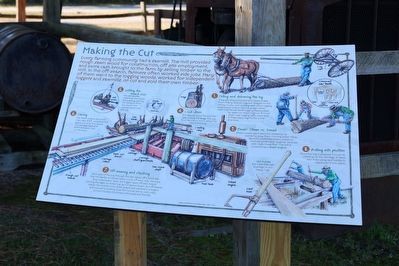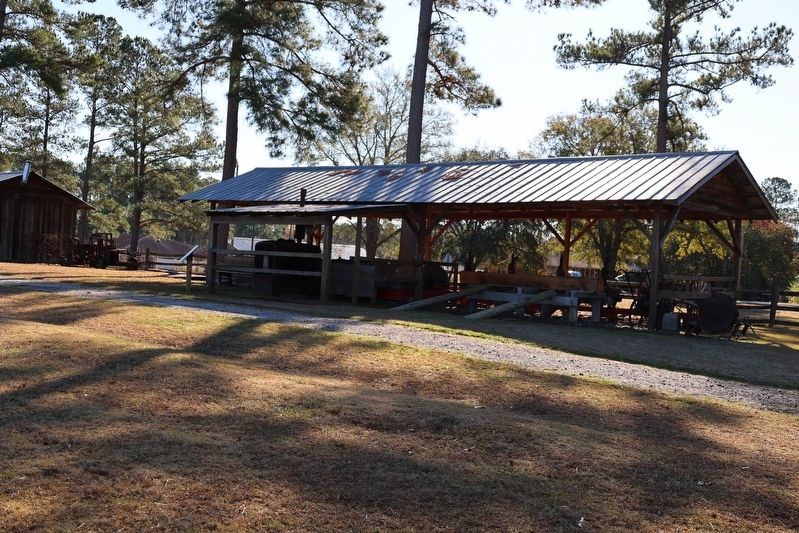Conway in Horry County, South Carolina — The American South (South Atlantic)
Making the Cut
— L.W. Paul Living History Farm —
1. Felling and delivering the log
Trees are dropped by axe and crosscut saw from nearby woods. Logs are dragged to the mil by mules, oxen, and log carts. The logging large tracts of land and narrow gauge tracks were built to run small logging trams pulled by diesel or steam engines if rivers were near. Logging rafts were built to float many logs to the mill at one time.
2. Power: Steam vs. Diesel
Steam power gave sawmills versatility by operating away from running water. Many sawmills preferred steam power to internal combustion engines because slats made cheap fuel. This mill is powered by a diesel engine.
3. Rolling into position
Once the log is prepped, it must be rolled up to the carriage. It takes two men using cant hooks to maneuver it into place.
4. Lock Down
The sawyer locks the log into place using the dogs. The log must be locked down while the belt is moving.
5. Setting the board size
The set works calibrate the board thickness by setting the distance from the saw to the desired depth into the log.
6. Sawing
The diesel engine spins the main saw shaft, as well as the gears and belts that move the carriage back and forth between cuts on the track.
7. Off-bearing and stacking
With each pass of the log through he saw takes off a size slab. First, the backs, or barked slabs, come off each side, leaving a four-sided beam. Next, the logger saws off each board, turning the cant, or milled log, as it is sawed down. An off-bearer stacks the boards to be dried. Boards are stacked in a wagon and moved to building sites for homes, barns, corn cribs, school houses, churches, outhouses, and the like.
Erected by L.W. Paul Living History Farm.
Topics. This historical marker is listed in these topic lists: Education • Parks & Recreational Areas.
Location. 33° 54.309′ N, 79° 2.932′ W. Marker is in Conway, South Carolina, in Horry County. Marker can be reached from Harris Short Cut Road west of U.S. 701, on the right when traveling west. Touch for map. Marker is at or near this postal address: 2279 Harris Short Cut Rd, Conway SC 29526, United States of America. Touch for directions.
Other nearby markers. At least 8 other markers are within walking distance of this marker. Working Iron (a few steps from this marker); Wood to Wagon (a few steps from this marker); Gristmill (within shouting distance of this marker); Raising Cane (within shouting distance of this marker); Raising Tobacco (within shouting distance of this marker); L.W. Paul Living History Farm (about 300 feet away, measured in a direct line); The Legacy of Farm to Table (about 400 feet away); Farm House (about 400 feet away). Touch for a list and map of all markers in Conway.
Also see . . . The L.W. Paul Living History Farm. Horry County Museum (Submitted on December 6, 2023.)
Credits. This page was last revised on December 6, 2023. It was originally submitted on December 6, 2023, by Sandra Hughes Tidwell of Killen, Alabama, USA. This page has been viewed 47 times since then and 6 times this year. Photos: 1, 2. submitted on December 6, 2023, by Sandra Hughes Tidwell of Killen, Alabama, USA. • Bernard Fisher was the editor who published this page.

